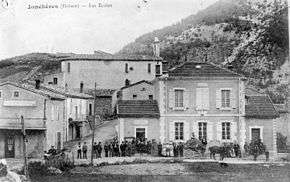Jonchères
| Jonchères | |
|---|---|
|
| |
 Jonchères | |
|
Location within Auvergne-Rhône-Alpes region  Jonchères | |
| Coordinates: 44°34′22″N 5°24′21″E / 44.5728°N 5.4058°ECoordinates: 44°34′22″N 5°24′21″E / 44.5728°N 5.4058°E | |
| Country | France |
| Region | Auvergne-Rhône-Alpes |
| Department | Drôme |
| Arrondissement | Die |
| Canton | Luc-en-Diois |
| Intercommunality | Diois |
| Government | |
| • Mayor (2014–2020) | Yann Fontaine |
| Area1 | 16.68 km2 (6.44 sq mi) |
| Population (2008)2 | 37 |
| • Density | 2.2/km2 (5.7/sq mi) |
| Time zone | CET (UTC+1) |
| • Summer (DST) | CEST (UTC+2) |
| INSEE/Postal code | 26152 / 26310 |
| Elevation |
719–1,560 m (2,359–5,118 ft) (avg. 910 m or 2,990 ft) |
|
1 French Land Register data, which excludes lakes, ponds, glaciers > 1 km² (0.386 sq mi or 247 acres) and river estuaries. 2 Population without double counting: residents of multiple communes (e.g., students and military personnel) only counted once. | |

Jonchères is a commune in the Drôme department in southeastern France, in the region of Auvergne-Rhône Alpes. It is located in the Béous valley, an affluent of the left bank of the Drôme river. The village is on a small winding road that climbs from the town of Luc-en-Diois 8 kilometers away, toward Prémol Pass. The village is at an altitude of 911 meters, surrounded by mountains thick with fir and pine. The closest nearby villages are Poyols, Bellegarde-en-Diois and Volvent. Die, the sub-prefecture is 25 kilometers away. The name Jonchères comes from the Latin joncus, meaning rushes. The word jonchère in French means area of rushes, the grasslike marsh plants of the family Juncaceae. The stem of the rush is used in making chair seats, baskets, mats etc.
As of 2016, there were 32 inhabitants of the village. The evolution of the number of inhabitants is known through the census of the population effected in the village since 1698 (204 inhabitants). In 1789 there were 261 inhabitants, including children, servants and shepherds. However, it was specified in the census report that the number of inhabitants varied annually according to the number of servants and shepherds. Included in the report was the information that most of the illnesses recorded in Jonchères were due to malnutrition of its inhabitants most of whom were born poor. At the time, wheat, rye, vegetables and a little hay were grown, but no other crops because of the difficulties of watering. And there were high taxes to pay to the lords and bishops of Die.
The highest population recorded in Jonchères was in 1836 with 339 inhabitants. Since then, the population has steadily deceased: 164 in 1901, 69 in 1936, 50 in 1975.
In the mid 1800s, Jonchères had an annual fair on September 12. The main products of the village were rye, oats, walnuts and grazing.
In the 1900s, the farmers began to grow lavender on their fields. The last lavender field was abandoned in the early 2000s. Lavender is still a main crop in the Drôme region.
In 2016, only one farmer remained in the village with his flock of sheep. There are no shops in the village. The former communal oven was renovated into a small pizzeria-restaurant open only during vacations. At least half of the houses of the village are now owned by people outside of the village who use them as vacation homes.
Beautiful hiking is possible from Jonchères in all directions: the national Claps forest, the mountains of Volvent, ontenier, Proloubeau, Boutarinard, Premol Pass. (964 m. altitude)
Monuments and patrimony
Near Jonchères (east of the town of Luc-en-Diois) is an immense rock fall from a cliff edge that broke off some 400 years ago. The place is called "The Claps" and its "Saut de la Drôme" or waterfall resulting from the rock fall is listed as a "national patrimony" of France.
Population
| Historical population | ||
|---|---|---|
| Year | Pop. | ±% |
| 1911 | 130 | — |
| 1962 | 24 | −81.5% |
| 1968 | 39 | +62.5% |
| 1975 | 50 | +28.2% |
| 1982 | 37 | −26.0% |
| 1990 | 50 | +35.1% |
| 1999 | 35 | −30.0% |
| 2008 | 37 | +5.7% |
See also
References
| Wikimedia Commons has media related to Jonchères. |